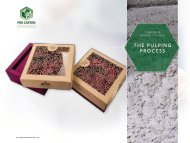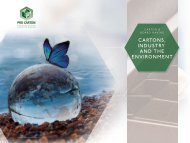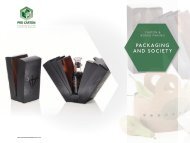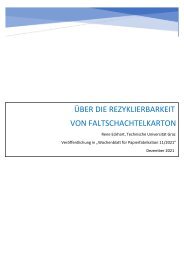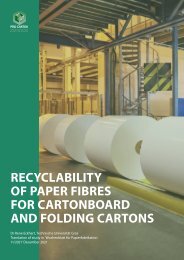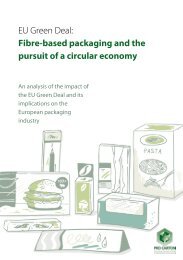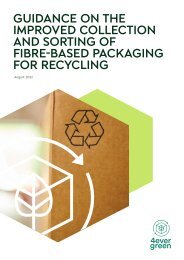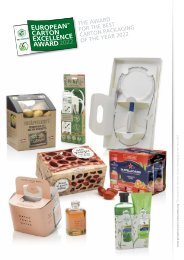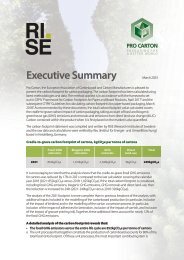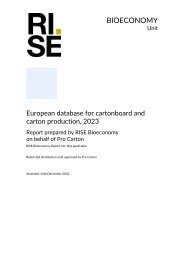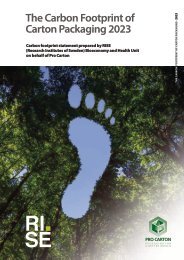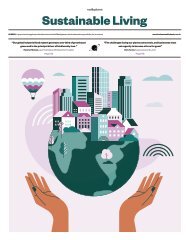Pro Carton Fact File – Module 3 – Forests – The Raw Material for Cartonboard
Create successful ePaper yourself
Turn your PDF publications into a flip-book with our unique Google optimized e-Paper software.
CARTON &<br />
BOARD MAKING<br />
FORESTS-<br />
THE RAW<br />
MATERIAL FOR<br />
CARTONBOARD<br />
THE CARTON PACKAGING FACT FILE
SUSTAINABLY MANAGED FORESTS<br />
WHY ARE FORESTS IMPORTANT FOR CARTONBOARD?<br />
Sustainable Forest Management is practised by European <strong>for</strong>est owners and operators who apply “sustainable<br />
development” principles when managing their <strong>for</strong>ests. <strong>The</strong>se cover environmental, economic and social aspects.<br />
<strong>The</strong> management of <strong>for</strong>ests <strong>for</strong> commercial production of wood fibre provides economic benefits to <strong>for</strong>est owners<br />
and employment, leisure and recreation opportunities.<br />
<strong>Forests</strong> are essential <strong>for</strong> the well-being of the environment and the planet as they help to reverse the greenhouse<br />
effect and stabilise the climate. <strong>Forests</strong> also help the control of water levels, prevent soil erosion and store<br />
solar energy.<br />
<strong>Forests</strong> and woodland cover over 182 million hectares in the EU, amounting to 42% of the EU being covered in <strong>for</strong>ests.<br />
(Eurostat 2018).<br />
CARTON &<br />
BOARD MAKING<br />
FORESTS-<br />
THE RAW<br />
MATERIAL FOR<br />
CARTONBOARD<br />
THE CARTON PACKAGING FACT FILE<br />
All contents copyright © BPIF 2017.
SUSTAINABLY MANAGED FORESTS<br />
WHAT IS THE “GREENHOUSE EFFECT”?<br />
<strong>The</strong> greenhouse effect occurs when heat from the sun is unable to escape from the earth’s atmosphere.<br />
This is considered to be due to the build-up of certain gases in the atmosphere which prevent the heat from<br />
escaping. This acts like glass in a greenhouse causing the temperature at the earth’s surface to rise. This is known as<br />
“global warming”.<br />
CARTON &<br />
BOARD MAKING<br />
FORESTS-<br />
THE RAW<br />
MATERIAL FOR<br />
CARTONBOARD<br />
<strong>The</strong> most common greenhouse gas is carbon dioxide. It is released when fossil fuels like coal, oil and natural gas are<br />
burned to produce energy in the <strong>for</strong>m of heat, electricity and in the internal combustion engine. <strong>The</strong> world’s use of<br />
fossil fuels releases about 5 billion tonnes of carbon per annum. <strong>The</strong> global average carbon dioxide level in 2020 was<br />
412.5 parts per million (Climate.gov 2020). Carbon dioxide levels today are higher than at any point in the past 800,000<br />
years (Climate.gov 2020).<br />
TREES HELP REVERSE THE GREENHOUSE EFFECT.<br />
Trees grow by absorbing carbon dioxide and releasing oxygen into the atmosphere. As trees grow they remove<br />
carbon from the atmosphere and help to reverse the “greenhouse effect”. This is known as “fixing” carbon.<br />
Trees absorb carbon dioxide by a process known as photosynthesis. In sunlight, trees, in common with all green<br />
leafed plants, convert carbon dioxide and water into simple sugars and oxygen. <strong>The</strong> sugars are polymerised naturally<br />
<strong>for</strong>ming cellulose fibres.<br />
INFLUENCE OF ALL MAJOR HUMAN-PRODUCED GREENHOUSE GASES, 1979-2017<br />
3<br />
Nitrous oxide<br />
CFC - 12<br />
Contribution to heating imbalance<br />
(Watts/square meter)<br />
2<br />
1<br />
CFC - 11<br />
Other minor gases<br />
1.0<br />
0.5<br />
Annual greenhouse gas index<br />
(Relative to 1990)<br />
0<br />
1980<br />
THE CARTON PACKAGING FACT FILE<br />
1990 2000<br />
Year<br />
0<br />
2010 2017<br />
NOAA Climate.gov<br />
Data: ESRL<br />
All contents copyright © BPIF 2017.
SUSTAINABLY MANAGED FORESTS<br />
HOW MUCH OF EUROPE IS FORESTED?<br />
In Europe about 40% of the land is <strong>for</strong>ested.<br />
HOW MUCH OF THE WORLD IS FORESTED?<br />
<strong>Forests</strong> cover 31% worldwide. Based on satellite images it is estimated that there are 400 billion trees worldwide.<br />
In Europe the largest <strong>for</strong>ests are in Finland where 66% of land is <strong>for</strong>ested and Sweden accounting <strong>for</strong> 63% of the<br />
land <strong>for</strong>ested. Coniferous <strong>for</strong>ests provide the main raw material <strong>for</strong> timber-based industries, including cartonboard.<br />
Coniferous trees are softwood and broadleafed trees are hardwood.<br />
Examples of softwood trees are pine, cedar, redwood spruce and birch.<br />
Examples of hardwood trees are beech, oak, teak and walnut.<br />
CARTON &<br />
BOARD MAKING<br />
FORESTS-<br />
THE RAW<br />
MATERIAL FOR<br />
CARTONBOARD<br />
HOW MUCH WOOD IS HARVESTED?<br />
In Europe, wood comes from sustainably managed <strong>for</strong>ests where the cycle of planting, growing and logging is<br />
carefully controlled. Cellulose fibre is the primary raw material <strong>for</strong> paper making. Of the fibre used by the<br />
European pulp and paper industry, 47% comes from virgin wood fibre and 53% from paper <strong>for</strong> recycling.<br />
It is in the interest of our industry to invest in healthy and growing <strong>for</strong>ests. For each harvested tree two to three<br />
new saplings should be planted to secure future sustainability.<br />
THE CARTON PACKAGING FACT FILE<br />
All contents copyright © BPIF 2017.
SUSTAINABLY MANAGED FORESTS<br />
FORESTS ARE NOT DESTROYED IN ORDER TO PRODUCE PAPER AND BOARD<br />
European <strong>for</strong>ests are large enough to provide all the fibre needed on a sustainable basis.<br />
<strong>The</strong> <strong>for</strong>est area in Europe is not decreasing, it is in fact increasing by the equivalent of 1500 football pitches every day.<br />
<strong>The</strong> long term impact on sustainably managed <strong>for</strong>ests also includes the ability to manage a mix of trees and adapt to<br />
changing climate conditions to secure healthy growth within the <strong>for</strong>ests <strong>for</strong> generations to come.<br />
Additionally, the volume of wood in the established <strong>for</strong>ests is increasing as the volume of annual new growth<br />
exceeds the volume harvested by around 45% (Cepi).<br />
<strong>The</strong> paper and board industry does not use wood from tropical rain<strong>for</strong>ests. This wood is not technically suitable.<br />
<strong>The</strong> real threat to tropical rain<strong>for</strong>ests comes from the need <strong>for</strong> agriculture. Every year about 12 million hectares of<br />
<strong>for</strong>est worldwide are cleared <strong>for</strong> agriculture and fuel, mostly in developing countries.<br />
CARTON &<br />
BOARD MAKING<br />
FORESTS-<br />
THE RAW<br />
MATERIAL FOR<br />
CARTONBOARD<br />
ARE THERE ANY THREATS TO FORESTS IN EUROPE?<br />
One of the greatest direct dangers to trees in Europe is from air pollution, droughts and insect damage. Air pollution<br />
arises from the burning of large quantities of non-renewable fossil fuels, such as coal and oil, which produce nitrous<br />
oxides and sulphur dioxide, in the more heavily populated and industrialised parts of Europe. This can be reduced by<br />
more efficient energy generation, flue gas cleaning and the use of “cleaner” fuels and sources of energy.<br />
THE CARTON PACKAGING FACT FILE<br />
All contents copyright © BPIF 2017.
SUSTAINABLY MANAGED FORESTS<br />
WHO OWNS THE FORESTS?<br />
In the major fibre producing countries - Finland and Sweden - two-thirds of <strong>for</strong>ests are privately owned by very large<br />
numbers of small land owners. Private ownership is also common in other countries together with a significant<br />
ownership by the state and other public bodies. Overall, the paper and board industry owns less than 10% of the<br />
<strong>for</strong>est area.<br />
CARTON &<br />
BOARD MAKING<br />
FORESTS-<br />
THE RAW<br />
MATERIAL FOR<br />
CARTONBOARD<br />
IF PAPER AND BOARD CAN BE RECYCLED WHY DO WE CUT DOWN TREES?<br />
A recycling rate of 84.2% means we need replenishment with fresh fibre to compensate <strong>for</strong> the gap of lost paper and<br />
board that is never recycled. For example tissues <strong>for</strong> personal hygiene, food contaminated packaging, tobacco paper,<br />
archived material, books and storage boxes consumers keep at home. <strong>The</strong>re is also a certain percentage of material lost<br />
which consumers do not make available <strong>for</strong> recycling. Such loss can only be replaced by new fibres from wood.<br />
Specific customer needs require additional virgin fibre. For example direct food contact requires virgin fibre material or<br />
specific requirements <strong>for</strong> stiffness and whiteness levels.<br />
WHAT SPECIES OF TREES ARE USED FOR PAPER AND BOARD PRODUCTION?<br />
In northern Europe the main species are spruce, pine and birch.<br />
In Spain and Portugal eucalyptus is grown commercially.<br />
THE CARTON PACKAGING FACT FILE<br />
All contents copyright © BPIF 2017.
SUSTAINABLY MANAGED FORESTS<br />
WHICH PARTS OF THE TREE ARE USED FOR PAPER AND BOARD MANUFACTURE?<br />
<strong>The</strong> paper and board industry uses <strong>for</strong>est thinnings, i.e. small trees which are removed so that the remaining trees<br />
grow to maturity and can be used <strong>for</strong> sawn timber.<br />
<strong>The</strong> industry also uses the small diameter tops of large trees and the round sections of the trunks which are<br />
removed in the saw mills (saw mill waste).<br />
CARTON &<br />
BOARD MAKING<br />
FORESTS-<br />
THE RAW<br />
MATERIAL FOR<br />
CARTONBOARD<br />
HOW IS SUSTAINABLE FOREST MANAGEMENT SECURED IN EUROPE?<br />
<strong>The</strong> <strong>for</strong>est industry has accepted the principle of sustainable development and has national <strong>for</strong>est certifications<br />
supporting sustainability through the PEFC and FSC certificated schemes in 129 Countries.<br />
WHAT IS “SUSTAINABLE DEVELOPMENT”?<br />
In 1987, the World Commission on Environment and Development issued its report, “Our Common Future”. This<br />
discussed the world’s <strong>for</strong>ests, climate change and other global environmental and development issues. <strong>The</strong> report<br />
introduced and defined sustainable development as “development that meets the needs of the present without<br />
compromising the ability of future generations to meet their own needs”.<br />
THIS IS HOW THE TRUNK IS USED<br />
<strong>The</strong> smallest wood is used to make particleboard and chipboard. This timber, as well as small trees,<br />
is also used as fuel.<br />
Small trunk parts are used to make paper and also paperboard - from which cartons are made.<br />
Thicker parts of the trunk are sawn into planks in the sawmill. Sawmill waste is used to make paper<br />
and also paperboard - from which cartons are made. <strong>The</strong> bark is used as fuel or <strong>for</strong> garden purposes.<br />
THE CARTON PACKAGING FACT FILE<br />
All contents copyright © BPIF 2017.
SUSTAINABLY MANAGED FORESTS<br />
HOW DOES “SUSTAINABLE DEVELOPMENT” APPLY TO FORESTRY?<br />
Sustainable <strong>for</strong>estry is, in the words of the European Agreement signed in Helsinki in 1993, “the stewardship and use<br />
of <strong>for</strong>ests and <strong>for</strong>est lands in a way, and at a rate, that maintains their bio-diversity, productivity and their potential<br />
to fulfil, now and in the future, relevant ecological, economic and social functions, at local, national and global<br />
levels, and that does not cause damage to other eco systems.”<br />
According to this definition European <strong>for</strong>ests used by the paper and board industry are sustainable. Every year new<br />
growth exceeds the wood harvested. <strong>Forests</strong> offer a natural habitat to vast numbers and different species of plants,<br />
animals and insects - they preserve this biodiversity and make a significant contribution to the maintenance of the<br />
world’s gene bank.<br />
CARTON &<br />
BOARD MAKING<br />
FORESTS-<br />
THE RAW<br />
MATERIAL FOR<br />
CARTONBOARD<br />
HOW CAN FOREST OWNERS PROVE THAT THEIR FORESTS ARE SUSTAINABLY MANAGED?<br />
Forest owners wishing to demonstrate that their <strong>for</strong>estry management practices con<strong>for</strong>m with the appropriate<br />
standard can apply to independent, third party, auditing bodies, either PEFC or FSC <strong>for</strong> assessment and certification.<br />
A number of assessment or “certification” schemes are in current use with over 70% of the <strong>for</strong>est area in Europe<br />
certified, (Cepi). In 2020, 224 million hectares were certified through the FSC (Forest Stewardship Council) scheme<br />
and 320 million hectares through the PEFC scheme (<strong>Pro</strong>gramme <strong>for</strong> the Endorsement of Forest Certification Systems).<br />
Both PEFC and FSC overlap in the types of <strong>for</strong>est trees certified including large state owned <strong>for</strong>ests to smaller private<br />
and family owned <strong>for</strong>ests.<br />
THE CARTON PACKAGING FACT FILE<br />
All contents copyright © BPIF 2017.
SUSTAINABLY MANAGED FORESTS<br />
Forest owners can also apply <strong>for</strong> independently audited environmental management schemes. Examples of such<br />
schemes are those based on ISO 14001 together with the EMAS scheme. A common feature of these schemes is a<br />
commitment to continuous, demonstrable, environmental improvement.<br />
WHAT IS MEANT BY “CHAIN OF CUSTODY”?<br />
In order to demonstrate that wood originates from a certified <strong>for</strong>est, producers of <strong>for</strong>est products need a “chain of<br />
custody” certificate. This provides traceability at each stage of processing.<br />
CARTON &<br />
BOARD MAKING<br />
FORESTS-<br />
THE RAW<br />
MATERIAL FOR<br />
CARTONBOARD<br />
CHAIN OF CUSTODY<br />
✓ ✓ ✓ ✓ ✓ ✓<br />
Sustainable<br />
<strong>for</strong>est<br />
management<br />
Pulpmill Pulp<br />
Paper & Board Paper & Board<br />
<strong>Pro</strong>ducts<br />
Certified<br />
<strong>Pro</strong>ducts<br />
THE CARTON PACKAGING FACT FILE<br />
All contents copyright © BPIF 2017.
KEY FACTS<br />
<strong>Forests</strong> are essential. <strong>The</strong>y reverse the greenhouse effect, stabilise climate and water levels,<br />
prevent soil erosion, store solar energy and preserve biodiversity. <strong>Forests</strong> also provide habitats<br />
<strong>for</strong> animals, plants and insects, protect watercourses and help to preserve the landscape.<br />
Sustainable managed <strong>for</strong>ests are expanding. More trees are being planted than harvested across<br />
Europe by an area equivalent to 1500 football pitches every day.<br />
Between 2005 and 2020 European <strong>for</strong>ests grew by 58,390 km 2 .<br />
Over 70% of <strong>for</strong>ests in the EU are certified under the FSC or PEFC. <strong>Forests</strong> and other wooded<br />
land in the EU amount to circa 180 million hectares, making Europe one of the most <strong>for</strong>est rich<br />
regions in the world. More than 42% of its land is covered by <strong>for</strong>ests.<br />
Most of the timber used in the cartonboard and paper industry comes from Europe.<br />
<strong>Carton</strong>board, like all paper and board, is made up from cellulose fibre.<br />
CARTON &<br />
BOARD MAKING<br />
FORESTS-<br />
THE RAW<br />
MATERIAL FOR<br />
CARTONBOARD<br />
THE CARTON PACKAGING FACT FILE<br />
All contents copyright © BPIF 2017.
ACKNOWLEDGEMENT<br />
<strong>Pro</strong> <strong>Carton</strong> would like to thank the following companies <strong>for</strong> contributing both in<strong>for</strong>mation and<br />
images to support the creation of these <strong>Fact</strong> <strong>File</strong>s:<br />
CARTON &<br />
BOARD MAKING<br />
FORESTS-<br />
THE RAW<br />
MATERIAL FOR<br />
CARTONBOARD<br />
THE CARTON PACKAGING FACT FILE<br />
ALL CONTENTS © PRO CARTON & UKFCA LTD. ALL STATISTICS CORRECT UP TO 2021<br />
All contents WWW.PROCARTON.COM<br />
copyright © BPIF 2017.



